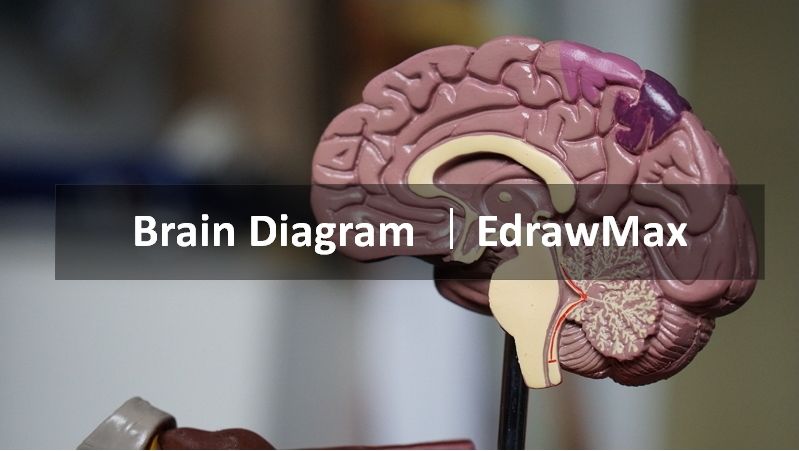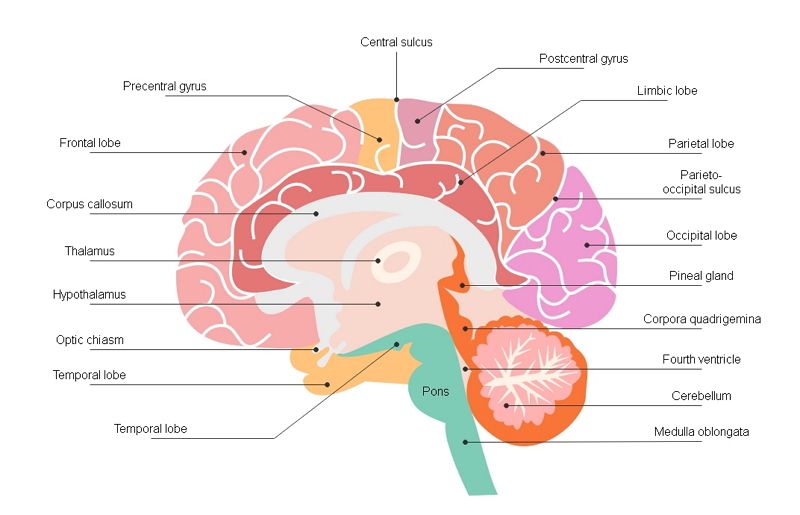The Anatomy of Human Brain with Diagram
Create a Brain Diagram Online Free Free Download Free Download Free Download Free Download1. The Anatomy of Human Brain
The human brain regulates nearly every part of the human body, from bodily processes to cognitive ability. This article will explore the anatomy of the human brain and visually depict it with a brain diagram.
The human brain contains functions of receiving and transmitting signals to various parts of the body through neurons. For most other mammals, the human brain has the same basic structure, but it is built better than any different mammalian brain.
The brain is a three-pound organ that regulates all body functions, interprets knowledge, and contains mind and soul essence. Intelligence, imagination, empathy, and memory are only a handful of the many aspects the brain regulates. The brain, within the skull, consists of the cerebrum, the cerebellum, and the brainstem.

1.1 Cerebrum
The cerebrum is the central portion of the brain, which consists of hemispheres right and left. Cerebrum performs higher functions such as reading touch, vision, hearing, thinking, reasoning, emotions, learning, and excellent movement control.
It is made up of the brain cortex and other subcortical structures. It consists of two cerebral hemispheres connected by thick, dense bands of fibers called the corpus callosum. While making a brain diagram, this will be a crucial element.
The cerebrum can be divided into four parts or lobes:
- Frontal lobe: This is related to sections of voice, preparation, thinking, problem-solving, and movement;
- Parietal lobe: Assist in movement, sensory perception, and orientation;
- Occipital lobe: This lobe deals with visual perceptions;
- Temporal lobe: This area is related to memory, auditory input, and speech perception and recognition. The cerebrum is responsible for thought, intellect, memory, and consciousness, which is also in charge of processing touch, sound, and vision.
1.2 Cerebellum
The cerebellum is the second-largest portion of the brain, found in the back of the medulla and pons. The cerebellum and the cerebrum are separated by cerebellar tentorium and transverse fissure. Cortex is the outer surface of the cerebellum and is called the foila for its parallel ridges.
Besides that, the cerebellum has the cerebellar's peduncles, the nuclei of the cerebellar, the anterior, and later lobes. The cerebellum is composed of two hemispheres, the black outer cortex, and the white inner medulla.
Besides, it is primarily responsible for the synchronization and preservation of the body balance during voluntary activity walking, running, riding, swimming, and precision control.
- Sensing equilibrium;
- Forwarding details;
- Coordinates movement through the head;
- It enables voluntary body movements to be controlled with precision;
- Predicts the body 's future location during a given motion.
1.3 Diencephalon
The diencephalon sits at the base of the human brain. It contains:
- Thalamus
- Epithalamus
- Hypothalamus
The thalamus serves as a form of relay station for signals that come into the brain. It's also interesting in the brain, sleep, and consciousness.
The epithalamus acts as a bridge between the limbic system and the rest of the brain. The limbic system is a part of the brain that has feelings, long-term memory, and actions.
The hypothalamus is the key element to offer homeostasis. It applies to the balance of all body functions.
1.4 Brain Stem
The brain stem is situated opposite the cerebellum and is connected to the spinal cord. It is composed of three essential parts:
- Midbrain
- Pons
- Oblongata Medulla
The midbrain helps to monitor the movement of eyes and process visual and auditory information. Also, it is the middle of the human brain. While making a brain diagram, this will be a crucial element.
Pons is the center of the brain stem. It is positioned under the midbrain. It is a group of nerves that help connect various parts of the brain. The pons also comprises some of the cranial nerves starting. Such nerves are involved in the processing of sensory input and facial gestures.
An oblongata medulla locates in the lower portion of the brain is the medulla oblongata. It functions as the heart and lungs work control center.

2. Symptoms of Brain Condition
There are mainly two kinds of brain symptoms which are the brain injury symptoms and brain tumor symptoms.
2.1 Brain Injury Symptoms
The brain is one of the most critical parts of your body, so it's crucial to identify signs that there might be a problem. Symptoms of brain damage are dependent upon the form and severity of the injury. While they often manifest shortly after a traumatic incident, hours, or days later, they can sometimes turn up.
Symptoms of general brain injury may include:
- Headache;
- Nausea or vomiting;
- Feeling confused or disoriented;
- Dizziness;
- Feeling fatigued or tired;
- Speech issues, like slurring, speaking more or less than normal;
- Dilution of either or both eyes;
- Fluid draining from your nose or ears;
- Seizures;
- Sensory disorders, such as blurred vision or ringing in your ears.
2.2 Brain Tumor Symptoms
Symptoms of the brain tumor depend on the size, location, and type of tumor. Symptoms of a general brain tumor can include:
- Headache;
- Sickness or vomiting;
- Loss of physical control, such as walking disabilities;
- Feeling tired;
- Feelings of exhaustion;
- Loss of appetite;
- Seizures or convulsions;
- Vision issues, hearing sounds, or voices;
- Difficulty concentration;
- Mood swings or changes in actions.
3. How to Keep A Healthy Brain
Boost your mental health by regularly reading, studying, or doing thought-provoking tasks such as crossword puzzles. Both of these aids activate the nerve cells and contribute to new brain cells being created.
When playing, contact sportswear a helmet always. Make sure you buckle up before you get into the car. Both of these habits can go a long way in preventing brain injuries.
4. Key Takeaways
Regular fitness exercises increase blood flow in your whole body, including your brain. Try checking in on your thoughts or emotions from time to time. Writing in a diary is a perfect way of getting into the habit. Look for any patterns of thinking or emotions that tend to affect your daily life and might affect your mental health.
EdrawMax is a brilliant full-featured application commonly adopted for making a brain diagram. Now users will create a perfect graph in moments with full impact with only a few clicks. It is extremely user friendly and offers 100% privacy when it comes to security.




